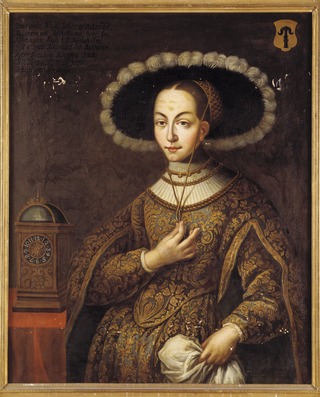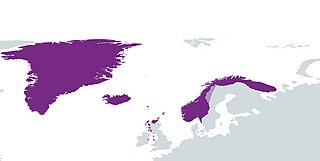Harald Gille, also known as Harald IV, was king of Norway from 1130 until his death. His byname Gille is probably from Middle Irish Gilla Críst "servant of Christ".

The Orkneyinga saga is a narrative of the history of the Orkney and Shetland islands and their relationship with other local polities, particularly Norway and Scotland. The saga has "no parallel in the social and literary record of Scotland" and is "the only medieval chronicle to have Orkney as the central place of action". The main focus of the work is the line of jarls who ruled the Earldom of Orkney, which constituted the Norðreyjar or Northern Isles of Orkney and Shetland and there are frequent references to both archipelagoes throughout.

Olaf III or Olaf Haraldsson, known as Olaf the Peaceful, was King of Norway from 1067 until his death in 1093.
Magnus Haraldsson was King of Norway from 1066 to 1069, jointly with his brother Olaf Kyrre from 1067. He was not included in official Norwegian regnal lists until modern times, but has since been counted as Magnus II.

Magnus III Olafsson, better known as Magnus Barefoot, was the King of Norway from 1093 until his death in 1103. His reign was marked by aggressive military campaigns and conquest, particularly in the Norse-dominated parts of the British Isles, where he extended his rule to the Kingdom of the Isles and Dublin.
Sigurd Haraldsson, also called Sigurd Munn, was king of Norway from 1136 to 1155. He was son of Harald Gille, king of Norway and his mistress Thora Guttormsdotter. He served as co-ruler with his half-brothers, Inge Haraldsson and Eystein Haraldsson. His epithet Munn means "the Mouth" in Old Norse. He was killed in the power-struggle against his brother, Inge, in an early stage of the civil war era in Norway.

The Fairhair dynasty was a family of kings founded by Harald I of Norway which united and ruled Norway with few interruptions from the latter half of the 9th century. In the traditional view, this lasted until 1387, however, many modern scholars view this rule as lasting only three generations, ending with Harald Greycloak in the late 10th century. The moniker "Fairhair dynasty" is a retrospective construction: in their lifetime what little traces there are refer to them consistently as "Ynglings".

The Diocese of Skara is the oldest existing diocese in Sweden. It was originally a Latin bishopric of the Roman Catholic church, but since the Protestant Reformation has been a Lutheran diocese within the Church of Sweden, with its seat in Skara at Skara Cathedral. In 2014, it celebrated its 1000-year anniversary as a full diocese.

Einar Eindridesson Thambarskelfir was an influential Norwegian noble and politician during the 11th century. He headed the feudal lords in their opposition to Olaf Haraldsson.

Saint Sigfrid of Sweden (Swedish: Sigfrid, Latin: Sigafridus, Old Norse: Sigurðr, Old English: Sigefrið/Sigeferð) was a missionary-bishop in Scandinavia during the first half of the 11th century. Originally from England, Saint Sigfrid is credited in late medieval king-lists and hagiography with performing the baptism of the first steadfastly Christian monarch of Sweden, Olof Skötkonung. He most likely arrived in Sweden soon after the year 1000 and conducted extensive missions in Götaland and Svealand. For some years after 1014, following his return to England, Sigfrid was based in Trondheim, Norway. However, his position there became untenable after the defeat of Olaf Haraldsson.

Rögnvald Kali Kolsson, also known as Saint Ronald of Orkney, was a Norwegian earl of Orkney who came to be regarded as a Christian saint. Two of the Orkney Islands are named after Rögnvald, namely North Ronaldsay and South Ronaldsay.
Jon Haraldsson was a Norwegian noble who served as the Jarl of Orkney between 1206 and 1231. Jon Haraldsson and his brother David were the sons of Harald Maddadsson with his second wife Hvarflod, daughter of Earl Máel Coluim of Moray. Jon and David were joint Earls of Orkney after the death of their father in 1206. David Haraldsson died of sickness in 1214, leaving Jon Haraldsson to rule alone. William the Lion, king of Scotland, took Jon's daughter hostage in August 1214 as part of a peace agreement with the new sole Earl.
Ingrid Ragnvaldsdotter was born a member of the Swedish royal family, became a member of Danish royalty by marriage and later was Queen consort of Norway as the spouse of Harald IV of Norway. Married four times, Ingrid had a number of children who played prominent roles in Swedish and Norwegian history.
Gunnhildr Sveinsdóttir or Gunnhildr Haraldsdóttir, Guda or Gyda was, according to the traditional view, a queen consort of King Anund Jacob of Sweden and of king Sveinn II of Denmark. However, the sources are so vague that several modern historians maintain that there were actually two queens of that name, of Sweden and Denmark respectively. She is sometimes called Gude or Gyridje, but this is probably because of confusion with her daughter, Gyda, who is also known under her mother's name Gunnhildr.
The Battle of Holmengrå was a naval battle fought on 12 November 1139 near the island Holmengrå south of Hvaler, between the forces of the child kings Sigurd Haraldsson and Inge Haraldsson on the one side, and on the other side the pretender Sigurd Slembe and his ally King Magnus the Blind. Inge and Sigurd Haraldsson were sons of the previous king Harald Gille, who had been killed by Sigurd Slembe in 1136. The sons of Harald Gille emerged victorious from the battle. Magnus the Blind was killed in action, while Sigurd Slembe was betrayed, captured, and later tortured and executed.
Magnus of Norway may refer to:
Magnus Haraldsson was a king of Norway from 1142 until his death around 1145, reigning together with three of his brothers. He was a son of King Harald Gille by an unknown concubine.

The Westrogothian rebellion, also known as Västgötabullret or Västgötaherrarnas uppror was a Swedish rebellion which took place in the provinces of Småland and Westregothia in Sweden during the spring of 1529. The rebellion was led by members of the Swedish nobility, and the purpose was to depose the Swedish King Gustavus Vasa in an attempt to end the recently initiated Swedish Reformation.

The term Norwegian Realm and Old Kingdom of Norway refer to the Kingdom of Norway's peak of power at the 13th century after a long period of civil war before 1240. The kingdom was a loosely unified nation including the territory of modern-day Norway, modern-day Swedish territory of Jämtland, Herjedalen, Ranrike (Bohuslän) and Idre and Särna, as well as Norway's overseas possessions which had been settled by Norwegian seafarers for centuries before being annexed or incorporated into the kingdom as 'tax territories'. To the North, Norway also bordered extensive tax territories on the mainland. Norway, whose expansionism starts from the very foundation of the Kingdom in 872, reached the peak of its power in the years between 1240 and 1319.









